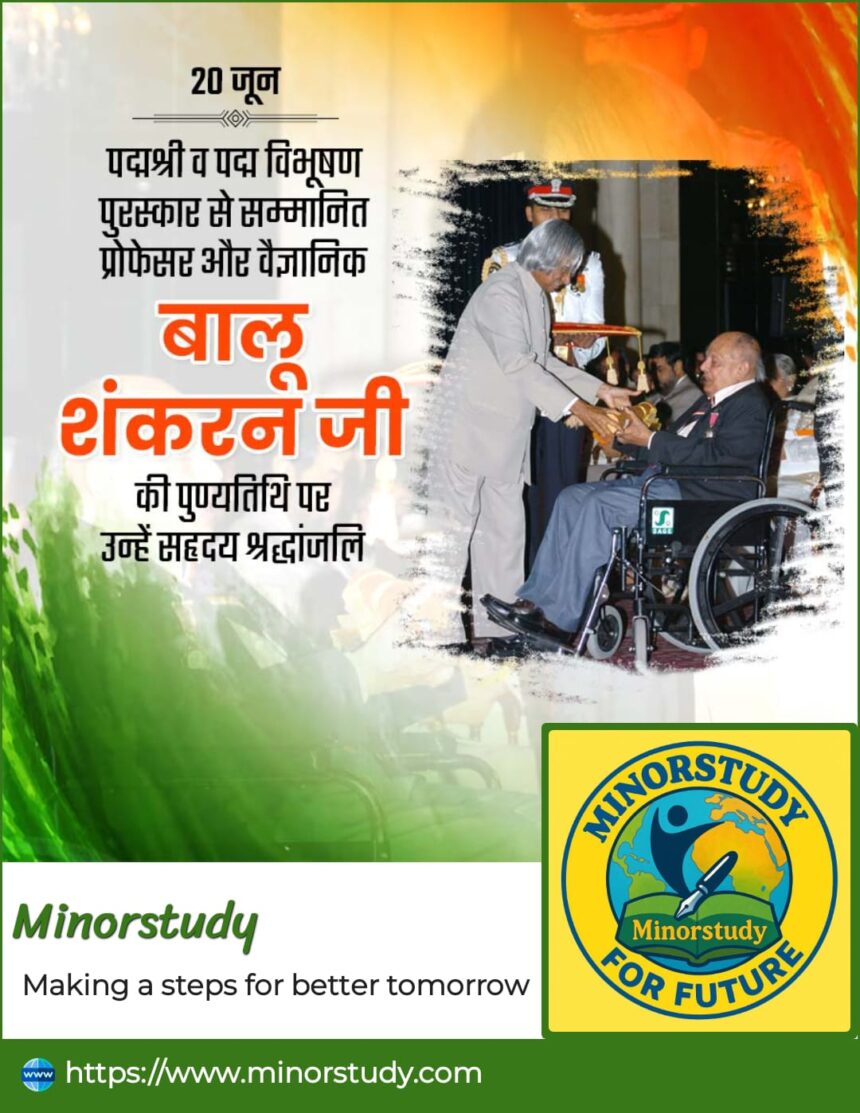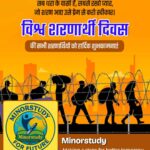🌟 Prof. Balu Sankaran: A Life That Transformed Rehabilitation in India
Prof. Balu Sankaran (1926–2012) wasn’t just an exceptional scientist and surgeon; he was a visionary whose work in orthopedics, artificial limbs, and rehabilitation reshaped healthcare for thousands in India. Honored with both the Padma Shri (1972) and Padma Vibhushan (2007), his legacy lives on in institutions and innovations that empower individuals with disabilities.
- 🌟 Prof. Balu Sankaran: A Life That Transformed Rehabilitation in India
- 📜 Prof. Balu Sankaran Biography & Early Life
- 🏛️ Prof. Balu Sankaran Major Career Milestones
- 1. AIIMS Delhi Leadership (1956–1967)
- 2. Rockefeller Fellowship and Research
- 3. Heading Maulana Azad Medical College (1967–1970)
- 4. Director, Central Institute of Orthopedics (CIO), Delhi (1970–1978)
- 5. World Health Organization (WHO), Geneva (1981–1987)
- 6. Rehabilitation Council of India (1992–1994)
- 7. Professor Emeritus, St. Stephen’s Hospital, Delhi
- 📅 Prof. Balu Sankaran Timeline of Prof. Sankaran’s Life & Career
- ✅ Prof. Balu Sankaran Top 8 Facts You Must Know
- 💡 Significance of Prof. Sankaran’s Legacy
- 🔹 1. Healthcare Access
- 🔹 2. Institutional Strength
- 🔹 3. Professional Development
- 🔹 4. Societal Integration
- 🔹 5. Global Standards
- ❓ FAQs About Prof. Balu Sankaran
- Q1: Who was Dr. Balu Sankaran?
- Q2: What awards did he receive?
- Q3: What is ALIMCO?
- Q4: What does NIRTAR do?
- Q5: How did he help injured soldiers?
- Q6: What roles did he play abroad?
- Q7: Did he impact rehabilitation training?
- Q8: Why is he called a visionary?
- 🎉 How to Celebrate & Honor His Legacy
- 🏘️ Impact in Daily Life & Society
- 📌 Key Takeaways
- ✍️ Wishing on His Birth or Death Anniversary
- 🧠 Conclusion: Human Compassion Engineered
📜 Prof. Balu Sankaran Biography & Early Life
Born: September 4, 1926, in Tamil Nadu, India
Education:
M.B.B.S., Stanley Medical College, Chennai, 1948
Advanced surgical training at Columbia Presbyterian Medical Center (USA, 1951–55) and Manchester Royal Infirmary (UK, 1955)
Career launch:
Joined AIIMS Delhi as Assistant Professor, Orthopedic Surgery, in 1956
Promoted to Associate Professor in 1963; served until 1967
🏛️ Prof. Balu Sankaran Major Career Milestones
1. AIIMS Delhi Leadership (1956–1967)
After completing his overseas training, Dr. Sankaran returned to India to help build the orthopedic department at AIIMS—India’s premier medical institution—where he served and trained future surgeons for over a decade .
2. Rockefeller Fellowship and Research
During a Rockefeller Foundation fellowship at the University of Chicago, he delved into basic medical research—advancing orthopedic science and bringing international experience back to India .
3. Heading Maulana Azad Medical College (1967–1970)
Dr. Sankaran took on greater responsibility and influence, shaping educational and clinical excellence in orthopedics.
4. Director, Central Institute of Orthopedics (CIO), Delhi (1970–1978)
Under his guidance:
Artificial Limbs Manufacturing Corporation of India (ALIMCO), Kanpur was established in 1972, producing affordable, locally made prosthetics .
National Institute of Rehabilitation Training and Research (NIRTAR) was set up near Bhubaneswar in 1975 to train professionals and support patients in rehabilitation .
5. World Health Organization (WHO), Geneva (1981–1987)
As WHO director, he expanded global rehabilitation frameworks, sharing India’s expertise internationally .
6. Rehabilitation Council of India (1992–1994)
He championed rehabilitation standards and training across India while serving as the council chair .
7. Professor Emeritus, St. Stephen’s Hospital, Delhi
In later years, Prof. Sankaran continued to inspire medical professionals and students through clinical teaching and mentorship .
📅 Prof. Balu Sankaran Timeline of Prof. Sankaran’s Life & Career
| Year | Milestone |
|---|---|
| 1926 | Born in Tamil Nadu (Sept 4) |
| 1948 | Completed medical degree (Stanley Medical College) |
| 1951–55 | Advanced training in USA & UK |
| 1956 | Joined AIIMS Delhi |
| 1963 | Promoted to Associate Professor, AIIMS |
| 1967–70 | Professor at Maulana Azad Medical College |
| 1970 | Became Director, CIO Delhi |
| 1972 | Founded ALIMCO, India’s key prosthetics manufacturer |
| 1972 | Awarded Padma Shri for rehabilitation work post-Bangladesh War |
| 1975 | Established NIRTAR for rehab training and research |
| 1978 | Retired from CIO Delhi |
| 1981–87 | Director at WHO, Geneva |
| 1992–94 | Chair, Rehabilitation Council of India |
| 2007 | Received Padma Vibhushan for lifetime contributions |
| 2012 | Passed away on June 20 after brief illness |
✅ Prof. Balu Sankaran Top 8 Facts You Must Know
Padma Shri Recipient (1972): For his pioneering work in trauma care and rehabilitation of injured soldiers post the 1971 Bangladesh War .
Padma Vibhushan Winner (2007): Recognized as one of India’s highest civilian honors for exceptional medical service .
Founder of ALIMCO: Spearheaded indigenous making of affordable prosthetic limbs in India.
Founder of NIRTAR: A dedicated national institute for rehabilitation in Odisha.
International leadership at WHO: Advanced global rehabilitation policies with India at the forefront.
Academic Roles: Mentored generations at AIIMS, St. Stephen’s, and Maulana Azad Medical College.
Rehabilitation Council Chair: Standardized Indian rehabilitation practices.
Global Vision with Local Heart: Blended international best practices with grassroots impact.
💡 Significance of Prof. Sankaran’s Legacy
🔹 1. Healthcare Access
He pioneered affordable rehab solutions that would have otherwise been inaccessible to thousands.
🔹 2. Institutional Strength
ALIMCO and NIRTAR endure as pillars enabling ongoing innovation and support in prosthetics and rehabilitation.
🔹 3. Professional Development
He nurtured a generation of orthopedic surgeons, prosthetists, and rehabilitation professionals.
🔹 4. Societal Integration
By restoring mobility, dignity, and independence, he helped millions reintegrate into society.
🔹 5. Global Standards
His tenure at WHO elevated India’s role in shaping rehabilitation norms worldwide.
❓ FAQs About Prof. Balu Sankaran
Q1: Who was Dr. Balu Sankaran?
An acclaimed Indian orthopedic surgeon and rehabilitation pioneer who received national honors for his transformative medical work.
Q2: What awards did he receive?
Padma Shri in 1972
Padma Vibhushan in 2007 .
Q3: What is ALIMCO?
A government-backed enterprise founded in 1972 in Kanpur to design and manufacture artificial limbs.
Q4: What does NIRTAR do?
It offers practical training and research in rehabilitation, set up by Dr. Sankaran in 1975.
Q5: How did he help injured soldiers?
He provided advanced trauma care and early rehabilitation to those injured in the 1971 Indo-Pak war, earning him the Padma Shri.
Q6: What roles did he play abroad?
He served as a WHO director in Geneva, shaping global rehabilitation policy.
Q7: Did he impact rehabilitation training?
Yes—through the Rehabilitation Council of India, he elevated training standards nationwide.
Q8: Why is he called a visionary?
He envisioned rehabilitation as integral to healthcare, not just an afterthought—a radical shift at the time.
🎉 How to Celebrate & Honor His Legacy
🔹 Professional Tributes: Cite his work during orthopedic or rehabilitation symposiums.
🔹 Institutional Homages: Hospitals and training centers may hold seminars on June 20 (his death anniversary) or September 4 (his birthday).
🔹 Inspirational Content: Share stories of patients helped through ALIMCO or NIRTAR.
🔹 Scholarships or Awards: Inspire young researchers in his name, based on affordable healthcare innovation.
🏘️ Impact in Daily Life & Society
👨🦯 Ordinary People
Countless amputees gained access to prosthetics due to ALIMCO’s low-cost devices.
👩⚕️ Healthcare Field
His standards for rehabilitation introduced interdisciplinary approaches—physical therapy, prosthetics, counseling—into mainstream medical care.
🎓 Education & Research
NIRTAR and ALIMCO fostered data-driven studies and mass training programs in rehabilitation.
🌍 National & Global Policies
His advocacy influenced Indian health policy and WHO’s disability frameworks.
📌 Key Takeaways
Born: September 4, 1926
Died: June 20, 2012
Major Awards: Padma Shri (1972), Padma Vibhushan (2007)
Founder: ALIMCO (1972), NIRTAR (1975)
Roles: Academic, WHO Director, Rehabilitation Council Chair
Legacy: Affordable rehab, institutional foundations, global influence
✍️ Wishing on His Birth or Death Anniversary
🕊️ “Remembering Prof. Balu Sankaran—whose vision enabled thousands to walk, live, and dream again. His legacy reminds us every step forward matters.”
🦾 “Honoring the memory of a man whose work brought hope to the disabled. We’re walking in the path he paved—literally and figuratively.”
🧠 Conclusion: Human Compassion Engineered
Prof. Balu Sankaran exemplified how science, humility, and commitment can merge to transform lives. His journey went beyond medicine; it was about restoring hope—in soldiers, civilians, amputees—through ingenuity and empathy.
From Stanley College to AIIMS, WHO, and grassroots institutions—he built bridges between ideal and real, policy and practice, international expertise and local need.
Today, every prosthetic limb from ALIMCO, every trained rehab professional, every patient walking independently, carries forward his vision. In doing so, he continues to teach that true progress in medicine is measured not just in knowledge but in renewed human potential.








